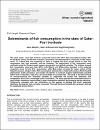Determinants of fish consumption in the state of Qatar: Post blockade
| Author | Abusin, Sana |
| Author | Al-Emadi, Noor |
| Author | Elmaghraby, Engi |
| Available date | 2021-05-24T08:09:39Z |
| Publication Date | 2020-11 |
| Publication Name | African Journal of Agricultural Research |
| Identifier | http://dx.doi.org/10.5897/AJAR2020.15143 |
| ISSN | 1991-637X |
| Abstract | This study used a count data model to analyse the factors that affect fish consumption in Qatar after the blockade; aiming for effective evaluation, formulation and implementation, of policies for the fishery sector. To achieve this, the community of Qatar is divided into three groups based on their fish consumption rate: high, moderate, and low consumer. The determinants of fish consumption were confirmed using the Poisson model, namely demographic and attitude variables. The findings showed that consumption rates were high (90%); both Qataris and White-collars belonged to the moderate consumers group (52 and 41%, respectively), while Blue-collars occupied the larger portion of the highest consumer category (36%). Fish consumption determinants in Qatar with positive effect included employment, health awareness, and number of children; in contrast, negative determinants included higher level of education, high price, and accessibility to purchase fish. The study is the first to focus on socio-economics and attitudinal variables to understand the factors that determine fish consumption that in turn, encourages policy formulation. The study supports the government policy to open foreign investment opportunities to meet consumption demands and preserve marine resources. Furthermore, managers may use information on fish species to manage fish stock, especially identifying fish species that are highly consumed. They will therefore formulate the necessary policies for sustainable marine fishery |
| Language | en |
| Publisher | Academic Journal |
| Subject | Marine consumption Qatar blockade tilapia sustainability |
| Type | Article |
| Pagination | 1496-1502 |
| Issue Number | 11 |
| Volume Number | 16 |
Files in this item
This item appears in the following Collection(s)
-
Social & Economic Survey Research Institute Research [297 items ]


